
Soil Mechanics Testing Equipment

Standards
BS 1377:5, ASTM D2435, ASTM D3877, ASTM D4546, AASHTO T216, NF P94-090-1, NF P94-091, UNE 103-405, UNE 103-602






Description
Automatic Computerized Oedometer allows determines the rate and magnitude of consolidation of a soil specimen restrained laterally and subjected to a number of successive increments of vertical loads. In this automatic model, the incremental loading, in the load (stress) or swelling (strain) mode, is fully automatic for a practical and accurate test execution with more reliable test results. The ACE unit, the SHEARMATIC Automatic shear testing machine and AUTOTRIAX Automatic triaxial test systems, are the unique equipment for the complete automation of a CST (Consolidation, Shear, Triaxial) Soil Mechanics laboratory in the different configurations. Read more in our mega blog!
The ACE, Automatic Computerized oedometer, consists of a small and compact load frame housing two coaxial pneumatic cylinders: the smallest one for low loads and the other for higher loads, with automatic switch off from one to the other when needed. The load is controlled by a high precision pneumatic servo-valve. Two analogue channels: one for the displacement transducer and the other for the load cell with closed loop feedback control. The test end can be programmed on a time or on a step bases. The software can control from a single PC, up to 60 ACE units enabling the operator to choose from single to multiple control.
Test parameters are previously specified by the operator and set in the ACE software. Test results are recorded and displayed in real time on the PC and calculation are performed automatically. The test data can be processed by one of the Geo-Analysis Templates conforming to the BS or ASTM Standards.
The frame can accept all standard consolidation cells: from 50.47 to 112.80 mm dia. Consolidation cells, Geo-Analysis templates and test software not included. See acc essories. PC not included.
Automatic Computerized Oedometer Main Features
- PC controlled fully automatic test execution
- Pneumatic system for incremental consolidation and one-dimensional swell tests
- Performance of 24 hours 7 days tests without interruption and greater through output of tests with a considerable cost decrease
- To avoid the negative environmental discrepancies as operator errors, non-calibration etc.
- 15 kN max. capacity, 10 mm travel displacement transducer
- Real time data and graph display
- Single ACE software controlling up to 60 units
- Test management software supplied including calibration menu
- High speed LAN network communication
Automatic Computerized Oedometer TechnicalSpecifications
| NG-ACE | |
|---|---|
| Maximum Vertical Load | 15 kN |
| Load Cell Cap | 15 kN |
| Displacement Transducer | 10 mm maximum travel |
| Maximum Air Pressure Supply | 10 bar. If the air pressure line is not available in the laboratory, our Air compress model NG-D2015, 50L capacity may be used |
| Sample Dimensions | From 50.47 to 112.8 mm diameter using our consolidation cells. See accessories |
| Software | Can control up to 60 ACE units (not included, see accessories) |
| PC Connection | LAN Connection to PC |
| Test Data Accuracy | ±1% |
| Overall Dimensions | 11" x 11.8" x 23.6" / 28 x 30 x 60 cm |
| Approximate Weight | 56lbs / 25 kg |
Consolidation Cells
To perform either standard or permeability testing:
| Model | Specimen Dia. x Height [mm] | Specimen Area [cm2] | Cell Dimension Dia. x Height [mm] | Weight [kg] | Calibration Disk |
|---|---|---|---|---|---|
| NG-WF0320 | 50.47 x 20 mm | 20 cm2 | 139 x 74 mm | 1.3 kg | NG-WF0320/9 |
| NG-WF0321 | 63.50 x 20 mm | 31.67 cm2 | 139 x 74 mm | 1.3 kg | NG-WF0321/9 |
| NG-WF0325 | 71.40 x 20 mm | 40 cm2 | 139 x 74 mm | 1.3 kg | NG-WF0325/9 |
| NG-WF0326 | 75 x 20 mm | 44.16 cm2 | 139 x 74 mm | 1.3 kg | NG-WF0326/9 |
| NG-WF0335 | 112.80 x 25 mm | 100 cm2 | 200 x 74 mm | 3 kg | NG-WF0335/9 |
FAQs
Yes, the Automatic Computerized Oedometer meets the ASTM D2435 Standard. This standard, established by ASTM International, specifies the procedures for one-dimensional consolidation testing of soils. These tests are critical for evaluating soil's settlement behavior and mechanical properties under various loading conditions, which is a key aspect of geotechnical engineering and soil mechanics.
The ACE's design and functionality are tailored to perform these specific tests, ensuring it complies with the rigorous requirements of ASTM D2435. This includes the ability to apply incremental loads in a controlled manner and accurately measure the soil specimen's response, capabilities that are essential for adherence to ASTM D2435. The standard is widely recognized in the field of civil engineering and is essential for assessing the consolidation characteristics of soils, particularly in the context of construction and foundation design.
By meeting the ASTM D2435 Standard, the ACE demonstrates its reliability and precision in conducting soil consolidation tests, which are crucial for geotechnical assessments and research. The equipment's compliance with this standard not only underscores its technical proficiency but also ensures that it can be confidently used in various professional settings where ASTM standards are the benchmark for soil testing and analysis.
Click here to learn more about the product or here to receive a personalized quote.
Yes, the Automatic Computerized Oedometer (ACE) complies with the ASTM D3877 Standard. This standard, set by ASTM International, outlines the specific procedures for running one-dimensional swell or consolidation tests under constant rate of strain. Such tests are vital for understanding the swelling or consolidation behavior of soils, especially in situations where soil stability and structural integrity are of concern.
The ACE is precisely engineered to meet the requirements of ASTM D3877. It features automatic loading capabilities in both stress and strain modes, which are essential for conducting constant rate of strain tests as stipulated in this standard. The ability of the ACE to perform these tests accurately is crucial for determining the soil’s response to changes in moisture content and stress conditions, which are key factors in many geotechnical engineering projects.
Adhering to ASTM D3877, the ACE ensures that its performance in soil testing is both reliable and consistent with international standards. This compliance is particularly important for engineers and researchers who rely on standardized methods to assess soil properties in various construction, environmental, and research applications. The Automatic Computerized Oedometer's alignment with ASTM D3877 reinforces its utility and trustworthiness in professional and academic settings that require stringent adherence to established soil testing protocols.
Click here to learn more about the product or here to receive a personalized quote.
Yes, the Automatic Computerized Oedometer complies with the ASTM D4546 Standard. This standard, developed by ASTM International, is crucial for conducting one-dimensional swell or consolidation tests on soils using incremental loading. These tests are essential for evaluating soil behavior under various loading scenarios, a key aspect in geotechnical engineering and construction projects.
The ACE is specifically designed to meet the technical requirements of ASTM D4546. It features a sophisticated system for applying incremental loads automatically, in both stress (load) and strain (swelling) modes. This capability is crucial for the execution of tests as specified in ASTM D4546, enabling accurate and reliable assessment of soil properties under different loading conditions.
Compliance with ASTM D4546 signifies the ACE's commitment to maintaining high standards in soil testing. It assures users that the equipment is capable of delivering precise and consistent results, which are critical in determining the structural integrity and suitability of soils for various engineering applications. The adherence to such a recognized standard enhances the credibility of the ACE in professional environments, ensuring that it can be confidently used for a wide range of soil testing purposes, particularly those requiring detailed analysis of soil behavior under load.
Click here to learn more about the product or here to receive a personalized quote.
Yes, the Automatic Computerized Oedometer meets the AASHTO T216 Standard. This standard, established by the American Association of State Highway and Transportation Officials (AASHTO), specifies the procedures for one-dimensional consolidation tests of soils used in highway construction. These tests are critical for understanding soil behavior, especially in terms of settlement and deformation under load, which are key factors in road and highway engineering.
The ACE's advanced features and functionality are in line with the requirements of AASHTO T216. It has the capability to accurately apply incremental loads in both stress and strain modes, an essential aspect for conducting the consolidation tests defined in this standard. The equipment's precision in measuring the response of soil specimens under these conditions is vital for assessing soil characteristics relevant to highway construction and maintenance.
By meeting the AASHTO T216 Standard, the ACE demonstrates its suitability for use in the field of highway engineering, where accurate and reliable soil testing is paramount. Compliance with this standard ensures that the ACE can be confidently employed in projects that require thorough understanding of soil behavior in response to the specific conditions encountered in road construction. This makes the ACE a valuable tool in the arsenal of engineers and researchers working in the field of transportation infrastructure development and assessment.
Click here to learn more about the product or here to receive a personalized quote.
Yes, the Automatic Computerized Oedometer complies with the NF P94-090-1 Standard. This standard is part of the French norm NF P94 series, which sets out the procedures and requirements for testing soil mechanics for civil engineering purposes. Specifically, NF P94-090-1 focuses on the one-dimensional consolidation test of soils, an essential aspect of evaluating soil behavior under pressure, which is crucial in various engineering and construction projects.
The ACE is designed to meet the rigorous specifications of NF P94-090-1. Its features, including automatic incremental loading in both stress and strain modes, align perfectly with the standard's requirements for accurate and reliable soil consolidation testing. The capability of the ACE to perform these tests with precision is key to its compliance with NF P94-090-1, ensuring that it can effectively assess soil properties by French engineering standards.
Meeting the NF P94-090-1 Standard underscores the ACE's reliability and precision in conducting essential soil tests, which are critical for geotechnical assessments in France and other regions where this standard is recognized. The compliance of the ACE with such a specific and respected standard bolsters its credibility and utility in professional settings that require standardized and precise soil testing procedures, particularly in the context of civil engineering and construction planning.
Click here to learn more about the product or here to receive a personalized quote.
Yes, the Automatic Computerized Oedometer complies with the NF P94-091 Standard. This French standard, part of the NF P94 series, outlines specific requirements for the oedometer test, which assesses the compressibility and consolidation characteristics of soils. These tests are crucial in civil engineering to understand how soil behaves under varying degrees of pressure and load, particularly in the context of construction and infrastructure development.
The ACE is adeptly designed to align with the NF P94-091 Standard's specifications. It boasts features such as automatic incremental loading, both in stress and strain modes, which are critical for conducting oedometer tests as stipulated in this standard. The precision and reliability of the ACE in performing these tests are essential for it to meet the NF P94-091 requirements, ensuring accurate and consistent assessment of soil properties.
Adherence to the NF P94-091 Standard demonstrates the ACE's commitment to quality and precision in soil testing. This compliance is particularly significant for professionals and researchers in geotechnical engineering who rely on standardized methods to evaluate soil characteristics. The Automatic Computerized Oedometer's capability to meet the specific and stringent criteria of NF P94-091 enhances its utility and reliability in professional environments, particularly in France and other areas where this standard is applicable and respected.
Click here to learn more about the product or here to receive a personalized quote.
Yes, the Automatic Computerized Oedometer meets the UNE 103-405 Standard. This standard is part of the Spanish UNE framework, which sets guidelines for testing methods in soil mechanics for engineering purposes. Specifically, UNE 103-405 focuses on the testing procedures for determining the consolidation characteristics of soils, an essential aspect of soil mechanics and geotechnical engineering.
The design and operational capabilities of the ACE are tailored to conform to the specifications of UNE 103-405. This includes its ability to apply incremental loads automatically in both stress and strain modes, which is crucial for performing consolidation tests in line with this standard. Such functionality ensures that the ACE can accurately and reliably assess soil behavior under various loading conditions, a requirement of UNE 103-405.
By complying with the UNE 103-405 Standard, the ACE proves its efficacy in providing precise and dependable results in soil consolidation tests. This compliance is vital for engineers and researchers who depend on standardized and accurate testing methods, particularly in Spain and other regions where the UNE standards are recognized. The ACE's adherence to such a recognized standard reinforces its suitability for use in professional and academic settings that require rigorous and standardized soil testing procedures.
Click here to learn more about the product or here to receive a personalized quote.
Yes, the Automatic Computerized Oedometer complies with the UNE 103-602 Standard. Part of the Spanish UNE standards series, UNE 103-602 is specifically focused on soil testing procedures related to geotechnical engineering. This standard provides guidelines for testing soil properties, particularly in the context of assessing soil behavior under load, which is a critical aspect of civil and geotechnical engineering projects.
The ACE is adeptly engineered to meet the requirements set forth in UNE 103-602. Its sophisticated features, including the capability for automatic incremental loading in both stress and strain modes, align perfectly with the standard's criteria for accurate soil testing. This ensures that the ACE can effectively and reliably conduct tests that adhere to the rigorous specifications of UNE 103-602.
Compliance with UNE 103-602 is indicative of the ACE's commitment to high-quality, standardized testing. This alignment is particularly important in Spain and other regions where UNE standards are prevalent and relied upon. The ACE's adherence to UNE 103-602 enhances its credibility and trustworthiness in professional settings, ensuring that users can confidently employ this equipment for soil testing purposes that require adherence to specific, standardized procedures.
Click here to learn more about the product or here to receive a personalized quote.
The Automatic Computerized Oedometer is designed to determine both the rate and magnitude of consolidation in a soil specimen. This process is essential in soil mechanics, as it provides critical insights into how soil reacts under pressure. The soil specimen, which is laterally restrained to mimic natural conditions, undergoes a series of successive increments of vertical loads during the test.
This incremental loading is a pivotal aspect of the testing process, as it simulates various pressure scenarios that soil might encounter in real-world situations, such as construction or civil engineering projects. By assessing how the soil specimen consolidates – that is, how it decreases in volume and increases in density under these loads – the oedometer provides valuable data on the soil’s structural integrity and suitability for various applications.
The use of an Automatic Computerized Oedometer for these tests is particularly advantageous due to its precision and consistency in applying the vertical loads. This automation ensures that the testing process is not only more efficient but also yields highly reliable results. Understanding the rate and magnitude of soil consolidation is crucial for engineers and planners in making informed decisions about soil use and management in construction and environmental projects.
Click here to learn more about the product or here to receive a personalized quote.
The automatic model of the Automatic Computerized Oedometer significantly enhances test execution and reliability by automating the incremental loading process. This automation is critical in two distinct modes: load (stress) and swelling (strain). In the load mode, the machine applies vertical stress to the soil specimen, while in the swelling mode, it measures the soil's strain or expansion under these conditions.
This automation brings about practicality and accuracy in test execution. By automating the application of loads and measurement of swelling, the oedometer eliminates the potential for human error, which can occur in manual testing methods. Consistency in applying the exact amounts of stress and accurately measuring strain ensures that the test results are not only precise but also reproducible.
Furthermore, the reliability of the test results is greatly enhanced with this automatic model. The consistent application of load and measurement parameters means that the data collected is more trustworthy. This reliability is essential for soil mechanics tests, as these results are used in critical decision-making processes in construction, civil engineering, and environmental management projects. The automation in the Automatic Computerized Oedometer thus provides a robust and dependable means of assessing soil properties, crucial for professional and academic applications in geotechnical engineering.
Click here to learn more about the product or here to receive a personalized quote.
The ACE unit, along with the SHEARMATIC Automatic shear testing machine and AUTOTRIAX Automatic triaxial test systems, stand out as unique equipment for the complete automation of a CST (Consolidation, Shear, Triaxial) Soil Mechanics laboratory. This combination of advanced systems offers a comprehensive solution for soil testing, covering a wide range of essential tests in soil mechanics.
Firstly, the ACE unit specializes in consolidation tests, determining the rate and magnitude of soil consolidation under various loads. The SHEARMATIC machine is designed for shear testing, crucial for understanding the shear strength and behavior of soil samples. The AUTOTRIAX system, on the other hand, is focused on triaxial tests, which are integral for assessing the mechanical properties of soils under simulated conditions that mimic in-situ stresses.
The integration of these three systems in a single laboratory setup allows for the full spectrum of CST testing to be conducted efficiently and accurately. This synergy not only enhances the capability of the laboratory to perform a diverse range of tests but also ensures consistency and reliability in the results. The automation of these systems further contributes to their uniqueness, providing seamless operation and reducing the likelihood of human error, which is especially beneficial in settings that require high precision and repeatability in soil testing. Thus, the combination of the ACE, SHEARMATIC, and AUTOTRIAX systems forms a robust and comprehensive framework for a state-of-the-art CST Soil Mechanics laboratory.
Click here to learn more about the product or here to receive a personalized quote.
The Automatic Computerized Oedometer, known as ACE, is distinguished by its uniquely designed load frame, which is both small and compact. This frame houses two coaxial pneumatic cylinders, a critical feature that enhances its functionality and efficiency. The presence of two distinct cylinders is designed to accommodate a range of load applications – the smaller cylinder is used for low loads, while the larger one is utilized for higher loads.
This dual-cylinder setup is integral to the ACE's versatility in testing different soil types and conditions. The automatic switch-off feature between the two cylinders ensures that the machine can adapt to varying load requirements seamlessly. This transition between cylinders occurs automatically, depending on the load being applied to the soil specimen. This automatic switching not only optimizes the testing process but also contributes to the accuracy and reliability of the results.
Such a design feature makes the ACE highly suitable for a wide array of soil mechanics tests, providing the flexibility to accurately apply the necessary loads for different types of tests. The compact size of the load frame also adds to the practicality of the device, making it an efficient tool for laboratories where space optimization is essential. Overall, the design of the load frame in the ACE reflects a thoughtful integration of functionality, versatility, and space efficiency, crucial for modern soil testing laboratories.
Click here to learn more about the product or here to receive a personalized quote.
In the Automatic Computerized Oedometer (ACE), load control is achieved through a high-precision pneumatic servo-valve. This component is crucial for the accurate and precise application of loads during soil testing processes. The pneumatic servo-valve's high precision ensures that the exact amount of pressure needed for each test is consistently applied, an essential factor in obtaining reliable and reproducible results in soil mechanics studies.
The use of a pneumatic servo-valve for load control in the ACE offers several advantages. Firstly, it allows for smooth and precise adjustments of load, which is vital when conducting tests that require incremental loading under specific conditions. The precision of this valve ensures that each load increment is applied accurately, thereby maintaining the integrity of the testing process.
Additionally, the servo-valve's responsiveness and accuracy are key to automating the load application process, making the ACE highly efficient and user-friendly. This automation reduces the potential for human error and enhances the overall reliability of the test results. The integration of a high precision pneumatic servo-valve in the ACE thus represents a significant technological advancement in soil testing equipment, ensuring that the device can meet the stringent requirements of modern geotechnical engineering practices.
Click here to learn more about the product or here to receive a personalized quote.
The Automatic Computerized Oedometer (ACE) features two analogue channels that serve distinct and critical functions in the soil testing process. One channel is dedicated to the displacement transducer, while the other is connected to the load cell. Both channels are integral to the system's closed-loop feedback control, which is essential for accurate and precise soil testing.
The displacement transducer channel is responsible for measuring the deformation or displacement of the soil specimen under load. This measurement is crucial for understanding how the soil behaves when subjected to various pressures, providing valuable data on its consolidation characteristics and overall mechanical properties.
On the other hand, the channel linked to the load cell is designed to accurately measure the force or load applied to the soil specimen. This data is vital for ensuring that the loads applied during the test are within the specified parameters and for analyzing the soil’s response to these loads.
The closed-loop feedback control, facilitated by these two channels, allows for real-time monitoring and adjustments during the testing process. This system ensures that the test conditions remain consistent and controlled, leading to more reliable and reproducible results. The inclusion of these two analogue channels in the ACE enhances its capability to conduct comprehensive and precise soil tests, making it a valuable tool in the field of geotechnical engineering.
Click here to learn more about the product or here to receive a personalized quote.
How does the test end programming and software control work in the Automatic Computerized Oedometer?
In the Automatic Computerized Oedometer (ACE), the test's completion can be programmed based on either time or on a step-by-step basis. This flexibility allows operators to tailor the end of the test according to specific requirements of the soil testing procedure. For instance, the test can be set to conclude after a predetermined duration (time-based) or upon completion of a certain number of steps or stages in the testing process (step-based).
Additionally, the ACE is equipped with sophisticated software that enables the control of up to 60 ACE units from a single personal computer (PC). This feature significantly enhances the efficiency and scalability of soil testing operations. The software's capacity to manage multiple units simultaneously provides the operator with the flexibility to choose between controlling a single ACE unit or multiple units, depending on the laboratory's testing needs and workload.
This ability to program the test end and control multiple units from a single PC makes the ACE highly adaptable and efficient, especially in busy laboratory environments where multiple tests need to be conducted concurrently. The software's user-friendly interface and robust control capabilities ensure that operators can efficiently manage and monitor the testing process, leading to improved productivity and reliability in soil mechanics testing.
Click here to learn more about the product or here to receive a personalized quote.
In the Automatic Computerized Oedometer (ACE), test parameters are set by the operator prior to the commencement of a soil test. This process involves specifying various critical details that define how the test will be conducted. These parameters can include factors such as the magnitude of the load to be applied, the rate of load application, the duration of each load increment, and any specific conditions relevant to the soil specimen being tested.
Once these parameters are determined, they are inputted into the ACE software. This software serves as the control center for the test, managing and executing the specified parameters throughout the testing process. The ability to predefine these parameters allows for a high degree of customization and precision, ensuring that each soil test is tailored to the specific requirements of the experiment or project.
The flexibility and user-friendliness of the ACE software are key advantages, enabling operators to easily set and adjust test parameters as needed. This capability ensures that the soil testing process is not only efficient but also highly accurate, as the conditions of each test are carefully controlled and monitored by the software based on the operator's specifications. The integration of this software control system in the ACE thus enhances the overall functionality and effectiveness of the oedometer in soil mechanics testing.
Click here to learn more about the product or here to receive a personalized quote.
In the Automatic Computerized Oedometer (ACE), test results are managed and processed with high efficiency and accuracy. During soil testing, results are recorded and displayed in real-time on a connected personal computer (PC). This real-time display allows operators to monitor the progress of the test as it happens, providing immediate insights into the soil's behavior under the applied loads.
Additionally, all calculations related to the test are performed automatically by the software. This automation includes computations necessary for understanding the soil specimen's response to the testing conditions, such as changes in volume, density, and strength. Automatic calculations reduce the potential for human error and enhance the efficiency of the testing process, ensuring that the results are both reliable and quickly available.
Furthermore, the ACE software is equipped to process the test data using one of the Geo-Analysis Templates. These templates are designed to conform to specific standards, such as those set by the British Standards (BS) or the American Society for Testing and Materials (ASTM). The use of these standardized templates ensures that the test data is processed and presented in a format that is consistent with recognized industry standards, making it easier to interpret, compare, and utilize the results in various engineering and construction applications. This feature of the ACE makes it a valuable tool for soil testing in professional settings, where adherence to standard testing methodologies is crucial.
Click here to learn more about the product or here to receive a personalized quote.
The Automatic Computerized Oedometer (ACE) boasts significant capabilities in terms of test duration and cost efficiency. It is designed to perform tests continuously for extended periods – up to 24 hours a day, 7 days a week – without any interruption. This endurance allows for long-term testing scenarios, which are often necessary to accurately assess soil behavior under sustained loads or to observe slow consolidation processes.
The ability of the ACE to operate continuously for such extended periods enhances the throughput of soil tests. Laboratories can conduct more tests in a shorter time frame, increasing productivity. This is particularly beneficial in environments with high workloads or when multiple samples need to be tested concurrently.
Moreover, the continuous operation of the ACE leads to a decrease in overall testing costs. By maximizing the utilization of the equipment and reducing the need for constant supervision or manual intervention, the ACE helps lower labor costs and increases the efficiency of the testing process. The combination of extended test duration capabilities and cost efficiency makes the ACE a valuable asset in soil mechanics laboratories, offering both practicality and economic advantages in soil testing operations.
Click here to learn more about the product or here to receive a personalized quote.
The Automatic Computerized Oedometer (ACE) is designed with a maximum load capacity of 15 kilonewtons (kN) and is equipped with a 10 millimeter (mm) travel displacement transducer. These specifications are key to its functionality and versatility in soil testing applications.
The 15 kN maximum capacity indicates the highest level of load that the ACE can apply to a soil specimen. This substantial capacity makes the ACE suitable for a wide range of soil types and testing scenarios, accommodating various soil strengths and consolidation behaviors. The ability to apply such a significant load is crucial for accurately simulating the conditions that soils may encounter in real-world engineering and construction situations.
In conjunction with this load capacity, the 10 mm travel displacement transducer plays a vital role in measuring the deformation or displacement of the soil sample under load. This transducer provides precise measurements of how much the soil specimen compresses or expands during the test, which is essential for assessing its consolidation and compressibility characteristics.
Together, these specifications of the ACE - its 15 kN maximum load capacity and 10 mm travel displacement transducer - ensure that it can effectively meet the demands of rigorous soil testing protocols, providing accurate and reliable data for geotechnical analysis and engineering decision-making.
Click here to learn more about the product or here to receive a personalized quote.
High-speed LAN (Local Area Network) network communication is a crucial feature of the Automatic Computerized Oedometer (ACE), significantly enhancing its functionality. This type of communication allows for rapid and reliable data transfer between the ACE units and the controlling computer system.
The high-speed LAN network facilitates real-time data sharing and synchronization across multiple ACE units. This is particularly important when multiple units are being used simultaneously, as it ensures that all data is updated and accessible without delay. The fast communication speed helps in maintaining a seamless flow of information, which is essential for monitoring ongoing tests, adjusting parameters, and analyzing results promptly.
Additionally, the reliability of LAN network communication ensures that the connection between the ACE units and the control system remains stable, reducing the likelihood of data loss or communication errors. This stability is crucial in a laboratory environment where accurate data collection and analysis are paramount.
Click here to learn more about the product or here to receive a personalized quote.
The Automatic Computerized Oedometer (ACE) requires a maximum air pressure supply of 10 bar for optimal operation. This level of air pressure is necessary to effectively power the pneumatic components of the device, such as the servo-valves and cylinders, which are critical for applying accurate loads during soil testing.
In cases where a laboratory does not have an existing air pressure line suitable for this requirement, an alternative solution is provided. The recommended alternative is the Air compress model NG-D2015, which has a capacity of 50 liters. This air compressor model is designed to complement the ACE, ensuring that it receives the necessary air pressure for its functions.
The availability of this alternative air compressor model ensures that the ACE can be used in a wide range of laboratory settings, even those that do not have pre-existing pneumatic infrastructure. This flexibility enhances the usability and accessibility of the ACE, making it a practical choice for various soil testing applications in different environments. The provision of a dedicated air compressor model also guarantees that the ACE will operate efficiently and reliably, providing consistent results in soil mechanics testing.
Click here to learn more about the product or here to receive a personalized quote.
The Automatic Computerized Oedometer (ACE) is designed to accommodate a wide range of soil sample sizes, specifically those with diameters ranging from 50.47 mm to 112.8 mm. This range of sample dimensions is facilitated by the use of consolidation cells, which are integral components of the ACE for holding and testing the soil specimens.
The ability to handle soil samples of various sizes allows the ACE to be versatile and applicable in a multitude of soil testing scenarios. It can be used to test small soil samples typically used in laboratory experiments, as well as larger samples that may be more representative of field conditions. This flexibility is particularly important in geotechnical engineering and soil mechanics, where soil properties can vary significantly based on sample size and type.
The inclusion of consolidation cells that can accommodate such a range of sample dimensions ensures that the ACE can be used for a broad spectrum of soil testing applications. Whether for academic research, construction project analysis, or civil engineering studies, the ACE's capability to test different-sized soil samples makes it a valuable and adaptable tool in soil mechanics laboratories.
Click here to learn more about the product or here to receive a personalized quote.
The test data obtained from the Automatic Computerized Oedometer (ACE) boasts an impressive accuracy level, with a margin of error of only ±1%. This high level of accuracy ensures that the measurements and results generated by the ACE are extremely reliable and precise.
An accuracy of ±1% means that the data collected during soil testing - including measurements of soil deformation, load applied, and other critical parameters - is consistently close to the true value, with only a minimal potential deviation. This precision is crucial in soil mechanics and geotechnical engineering, where even small inaccuracies can significantly impact the interpretation of soil behavior and the decision-making process in construction and engineering projects.
The ACE's ability to provide such precise data reinforces its suitability for professional and academic applications where high accuracy is paramount. Whether for research purposes, construction planning, or engineering analysis, users can rely on the ACE to deliver dependable and precise soil test results, contributing to the overall quality and reliability of geotechnical evaluations and studies.
Click here to learn more about the product or here to receive a personalized quote.
The Automatic Computerized Oedometer (ACE) has compact and manageable overall dimensions, making it suitable for various laboratory spaces. The dimensions are 11 inches by 11.8 inches by 23.6 inches, or in metric units, approximately 28 centimeters by 30 centimeters by 60 centimeters.
These dimensions reflect the ACE's design, which prioritizes space efficiency without compromising on functionality. The compact size allows it to be easily accommodated in different laboratory settings, even those with limited space. Despite its relatively small footprint, the ACE is fully equipped to perform a wide range of soil tests with the precision and accuracy required in soil mechanics and geotechnical engineering.
The balance between size and functionality in the ACE's design makes it an ideal choice for laboratories looking to optimize their space while maintaining a high standard of soil testing capabilities. This compact size, combined with its advanced features, ensures that the ACE is both a practical and powerful tool for soil analysis.
Click here to learn more about the product or here to receive a personalized quote.
The Automatic Computerized Oedometer (ACE) has an approximate weight of 56 pounds, which is equivalent to about 25 kilograms. This weight indicates that the ACE is relatively lightweight for a piece of advanced soil testing equipment, contributing to its practicality and ease of handling in laboratory environments.
The moderate weight of the ACE makes it more manageable for transportation and installation compared to heavier equipment. This is particularly advantageous in scenarios where the oedometer may need to be moved or repositioned within the laboratory or transported to different locations. Despite its lighter weight, the ACE is designed to be sturdy and durable, ensuring that it can reliably perform a wide range of soil tests with the necessary precision and accuracy.
The weight of the ACE strikes a balance between portability and robustness, making it a user-friendly and efficient choice for soil mechanics testing in various settings.
Click here to learn more about the product or here to receive a personalized quote.
The NG-WF0320 model in the Automatic Computerized Oedometer series has specific and detailed specifications tailored for soil testing. These specifications include:
- Specimen Dimensions: The model accommodates a soil specimen with a diameter of 50.47 mm and a height of 20 mm. These dimensions are suitable for standard soil testing procedures, allowing for precise measurement of soil behavior under various conditions.
- Specimen Area: The area of the soil specimen that this model can test is 20 cm². This area size is significant as it determines the part of the specimen exposed to testing conditions, influencing the accuracy and relevance of the test results.
- Cell Dimensions: The cell in which the soil specimen is placed has dimensions of 139 mm in diameter and 74 mm in height. The cell size is important for ensuring the specimen is appropriately contained and subjected to uniform testing conditions.
- Weight: The NG-WF0320 model weighs 1.3 kg. This moderate weight makes the unit relatively easy to handle and maneuver within a laboratory setting, without sacrificing stability and robustness.
- Calibration Disk: The model comes with a calibration disk, referenced as NG-WF0320/9. This disk is used to calibrate the equipment, ensuring that the tests conducted are accurate and consistent.
Click here to learn more about the product or here to receive a personalized quote.
The NG-WF0321 model in the Automatic Computerized Oedometer series is equipped with specific features for effective soil testing. The key specifications of this model include:
- Specimen Dimensions: It is designed to accommodate a soil specimen with a diameter of 63.50 mm and a height of 20 mm. These dimensions are crucial for conducting precise soil tests, ensuring that the specimen is of a size that is representative for the testing procedures.
- Specimen Area: The model provides a testing area of 31.67 cm² for the soil specimen. The area size is important as it impacts the test's accuracy and the applicability of the results to real-world scenarios.
- Cell Dimensions: The cell, which houses the soil specimen for testing, measures 139 mm in diameter and 74 mm in height. The dimensions of the cell are key to accommodating the specimen securely and ensuring uniform application of testing conditions.
- Weight: The weight of the NG-WF0321 model is 1.3 kg. This moderate weight contributes to the equipment's ease of handling and maneuverability in a laboratory environment, while maintaining the necessary stability for accurate testing.
- Calibration Disk: This model comes with a calibration disk, identified as NG-WF0321/9. Calibration is essential for ensuring the precision and consistency of the test results, making this an important component of the equipment.
Click here to learn more about the product or here to receive a personalized quote.
The NG-WF0325 model is a part of the Automatic Computerized Oedometer series and comes with a set of specific features designed for effective soil testing. The specifications for this model are as follows:
- Specimen Dimensions: The model is designed for a soil specimen with a diameter of 71.40 mm and a height of 20 mm. These dimensions are essential for ensuring that the specimen fits properly in the testing apparatus and that the tests are conducted under standardized conditions.
- Specimen Area: This model provides a testing area of 40 cm² for the soil specimen. The size of the testing area is crucial as it directly affects the representativeness of the test results for the soil's properties.
- Cell Dimensions: The dimensions of the cell that contains the soil specimen are 139 mm in diameter and 74 mm in height. The cell size is important for making sure that the specimen is appropriately positioned and subjected to the testing process in a uniform manner.
- Weight: The NG-WF0325 model weighs 1.3 kg. This weight makes the unit manageable in terms of transport and setup in a laboratory, while also ensuring the equipment remains stable during testing.
- Calibration Disk: Included with this model is a calibration disk, referred to as NG-WF0325/9. Regular calibration of the equipment using this disk is vital to maintain the accuracy and reliability of the test results.
Click here to learn more about the product or here to receive a personalized quote.
The NG-WF0326 model is a specialized unit within the Automatic Computerized Oedometer series, designed for precise soil testing. The key specifications of this model are:
- Specimen Dimensions: It accommodates a soil specimen with a diameter of 75 mm and a height of 20 mm. These dimensions are critical for ensuring the accurate and consistent application of test conditions, as well as compatibility with standard soil testing procedures.
- Specimen Area: The NG-WF0326 model has a specimen testing area of 44.16 cm². The size of this area is significant as it impacts the test's representativeness and the applicability of its results in understanding soil behavior.
- Cell Dimensions: The cell for the soil specimen in this model measures 139 mm in diameter and 74 mm in height. These cell dimensions are essential for securely accommodating the specimen and ensuring uniform testing conditions.
- Weight: This model weighs 1.3 kg, a moderate weight that facilitates ease of handling and positioning in a laboratory setting. The weight is balanced to provide stability during testing while allowing for practical maneuverability.
- Calibration Disk: The NG-WF0326 model comes equipped with a calibration disk, identified as NG-WF0326/9. Regular calibration using this disk is crucial to maintain the precision and accuracy of the test results, ensuring the reliability of soil testing data.
Click here to learn more about the product or here to receive a personalized quote.
The NG-WF0335 model, as part of the Automatic Computerized Oedometer series, is designed with specific attributes for conducting soil tests. The specifications for this model are:
- Specimen Dimensions: This model is configured to hold a soil specimen with a diameter of 112.80 mm and a height of 25 mm. These dimensions are essential for ensuring the specimen is adequately sized for the tests, allowing for accurate representation of soil behavior under various conditions.
- Specimen Area: The NG-WF0335 model has a considerable specimen testing area of 100 cm². This larger area is significant for conducting tests on soil samples that require more surface area, potentially offering a more comprehensive analysis of soil properties.
- Cell Dimensions: The cell that contains the soil specimen for testing measures 200 mm in diameter and 74 mm in height. The increased cell size accommodates the larger specimen, ensuring proper fit and uniform application of testing conditions.
- Weight: The weight of this model is 3 kg, which is relatively heavier compared to some other models in the series. This added weight provides additional stability during testing, particularly important for larger soil specimens.
- Calibration Disk: Included with the NG-WF0335 model is a calibration disk, denoted as NG-WF0335/9. Calibration is vital for maintaining the accuracy and consistency of test results, making this an integral component of the equipment.
Click here to learn more about the product or here to receive a personalized quote.
Related Products
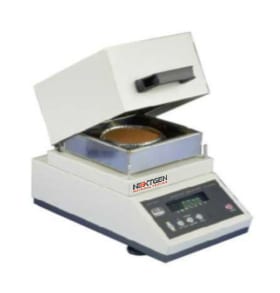
Moisture Determination Balance - GenMoist
GenMoist is designed to automatically and simultaneously dry and weight a solid sample for the determination of moisture content. The machine provides a continuous direct readout for both the weight and the percentage moisture loss through the entire cycle. It has a build-in timer.
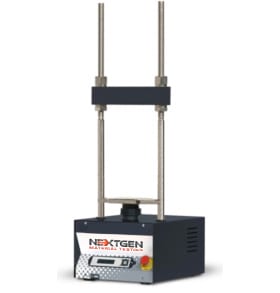
MULTISPEED Digital Automatic Universal Tester for Displacement Controlled Tests
The new MULTISPEED tester is the ideal solution for Road testing laboratory. The 50 kN capacity and the fully variable test speed of 0.2 to 51 mm/min make it possible to perform not only the CBR and Marshall tests, but many other applications as for instance Indirect Tensile test, Quick Triaxial tests, Unconfined and Uniaxial soil testing and, in general, all test to be performed under displacement control. The machine can be equipped with analogical or digital load/displacement measurement systems as well as with the specific accessories, to suit either the field or central laboratory requirement.
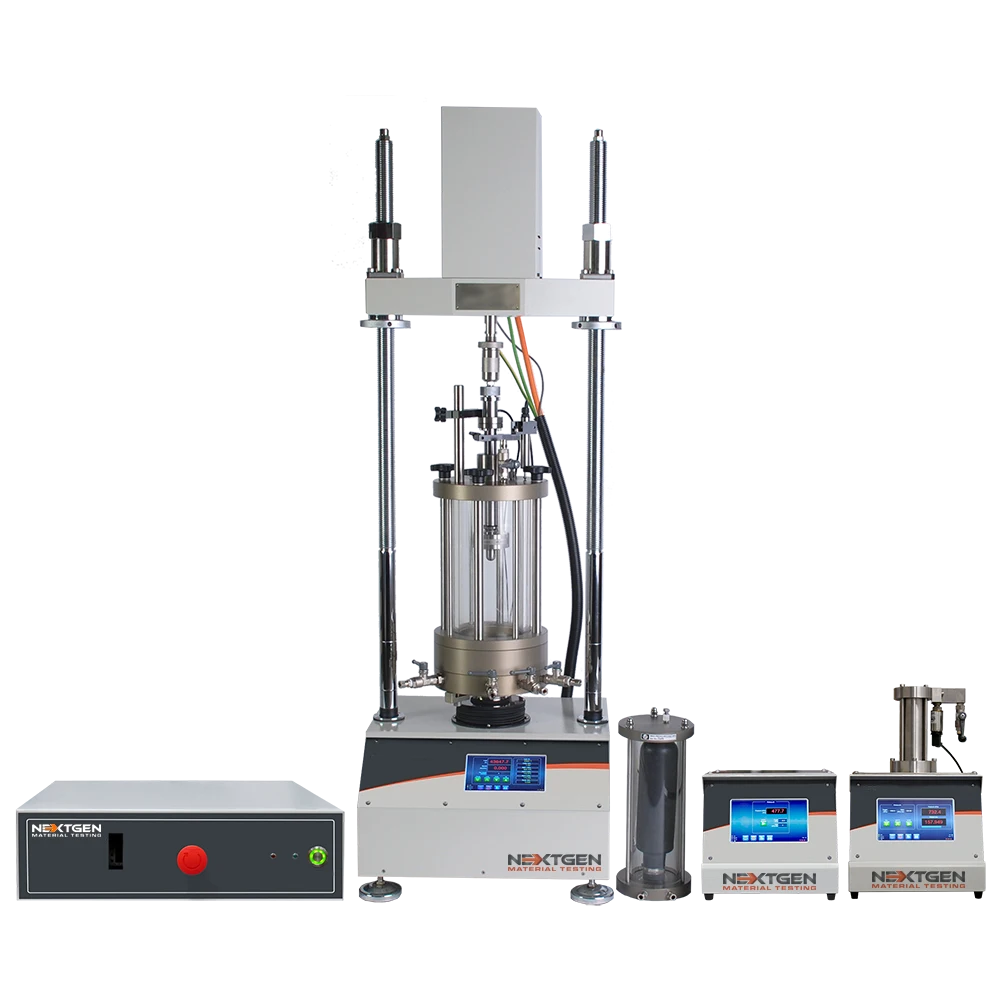
Dynamic Triaxial Systems 1000 kPa
Dynatriax systems are ideal for commercial and research laboratories for the following applications: Liquefaction potential, Strength degradation due to cyclic loading, Shear modulus and damping ratio, resilient modulus, Effects of blasting in mines and quarries, Effect of ocean waves on costal and off shore structures.
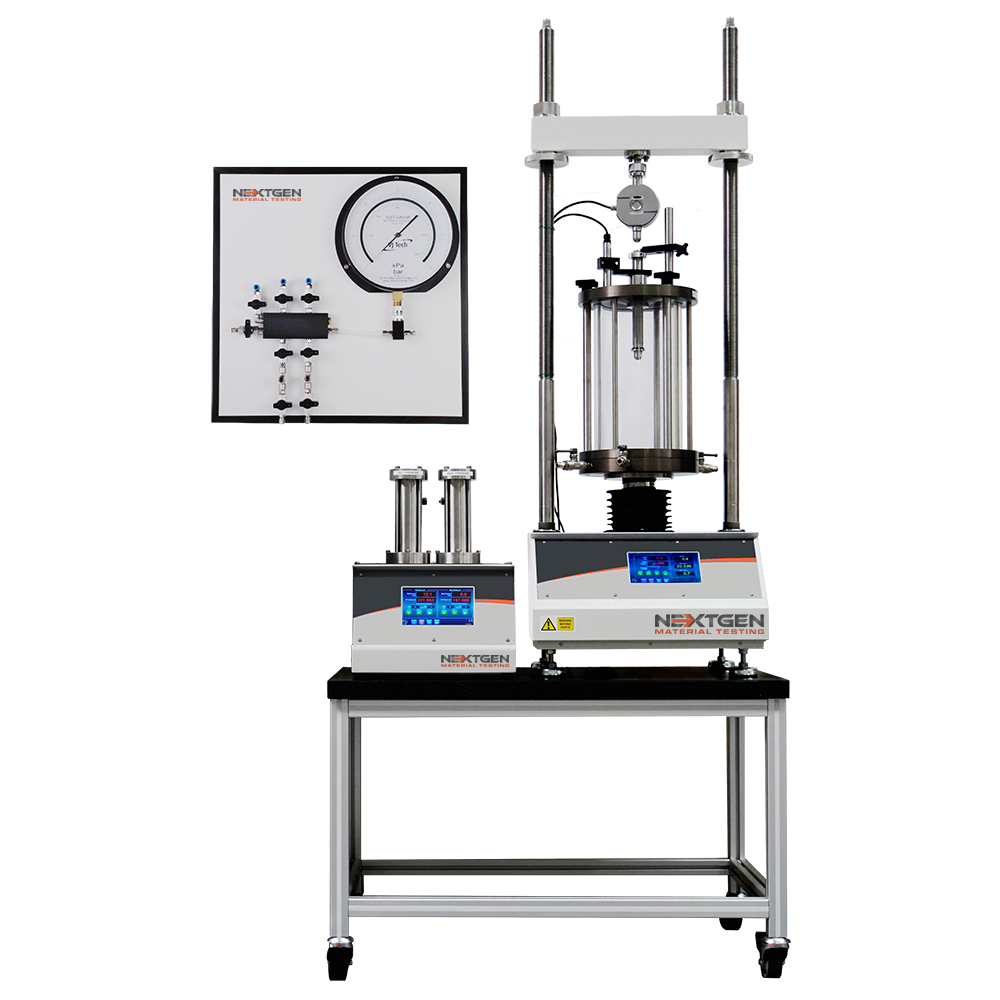
Automatic Triaxial Testing System
Automatic Triaxial Testing System for soil mechanics laboratory testing in compliance with the latest industry standards.
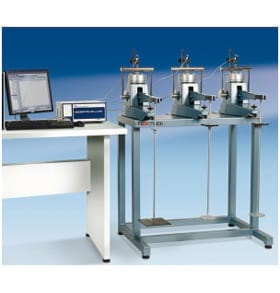
NG-Oedometer - Front Loading Oedometers - Consolidation Test
This test determines the rate and magnitude of consolidation of a soil specimen restrained laterally and subjected to a number of successive increments of vertical loads.
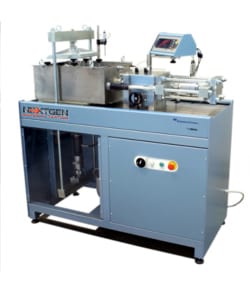
Shearmatic 300 - Large Shear Testing Machine
The SHEARMATIC 300 automatic machine is ideal for testing geosyntetics and also soil and other materials that contain large particles of up to 20 mm largest dimension. Sample size up to 300 mm square can be tested, with inserts allowing the testing of smaller sample sizes. See accessories.
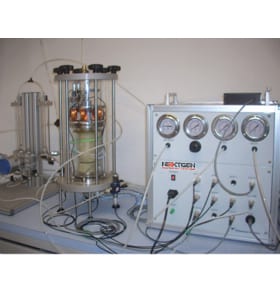
Resonant Column and Torsional Shear Tester
RESONANT COLUMN combines the features of both resonant column and torsional shear into a single unit including the current driven motor to apply torsional load to sample, a series of transducers with signal conditioning, a cell and back pressure electro-pneumatic control system and a data logger.
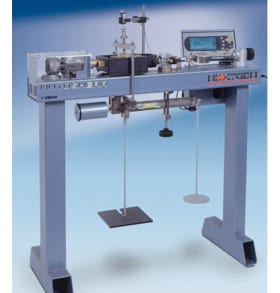
Automatic Shear Testing Machine
The microprocessor control system, therefore, allows the machine to work as an automatic stand-alone unit: the test measurements (force and displacements) a re directly displayed and stored in memory according to pre-set recording modes. The PC is only temporary required to download the test data via the RS 232 port once the test is completed. The data can be processed by the Direct and residual shear Geo-Analysis templates. See accessories.
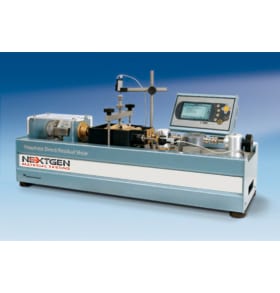
Shearmatic - Automatic Shear Testing Machine
This microprocessor based advanced model, is a stand-alone machine, driven by a high-resolution stepper motor with epicyclical reduction gear with reduced backlash. Incorporate a pneumatic closed loop system for the automatic application of the axial pressure by a high performance pressure regulator, with the main advantage of eliminating the manual loading of the dead weights. Excellent and high resistance techno-polymeric material has been adopted for the carriage of the shear box. It offers excellent resistance to corrosion, wear and tear and is resistant to all chemicals found in a soil specimen. The carriage is lightweight and easy to clean.
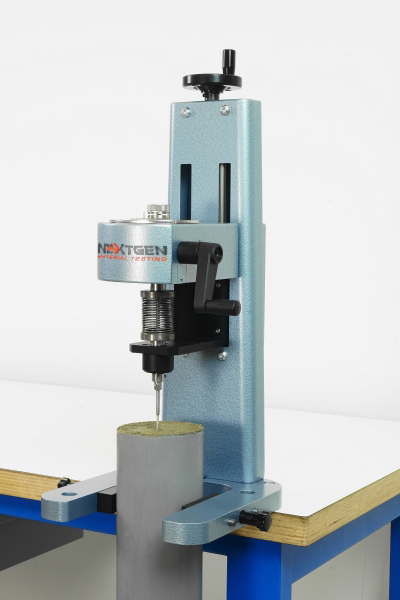
Laboratory Vane Apparatus
The laboratory vane apparatus is based on an original concept of the Transport and Road Research Laboratory of the United Kingdom. It offers versatility with a variety of vane sizes available. Typically it comes with the standard 12.7 mm square vane along with a set of four calibrated springs. Testing can be conducted either directly on the sample or within the sampling tube. For the latter, the NG-WF1738 Attachment for 38 and 100 mm diameter sampling tubes is recommended for optimal performance.